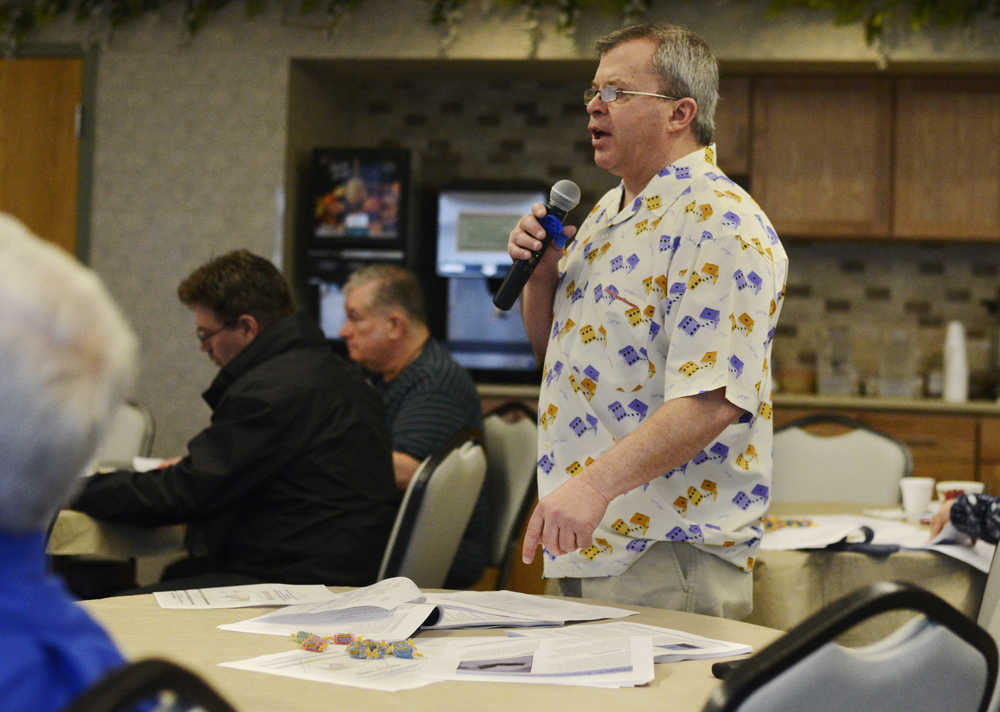Differences between versions of Kenai’s past comprehensive plans and resident preferences were hashed out at a meeting to update the city’s current plan.
A town hall-style discussion, intended to give Kenai leaders public input for the town’s comprehensive plan revision, drew 10 members and employees of the city government and three members of the public to the Kenai Senior Center on Saturday. This reporter attended the first hour and a half of the three-hour meeting.
The discussion formally begins Kenai’s update of its state-required comprehensive plan for land-use, a process that created controversy the last time it was attempted in 2013. That year voters rejected by referendum a plan revision that opponents said promoted developmental sprawl.
Planing consultant Elizabeth Benson of Anchorage-based Benson Planning, whom Kenai hired to lead the revision, moderated the discussion while writing comments on a flipchart and speaking into a microphone to create a recording. Benson structured the meeting around a review and discussion of the first four chapters of Kenai’s 2003 comprehensive plan — the most recent plan approved and the one currently in effect — and a comparison with the equivalent chapters of the rejected 2013 comprehensive plan. Benson described these informational chapters — an introduction and overviews of Kenai’s history, government, demographics, and economy, as well as the context and goals of the comprehensive plan — as “an inventory.”
“That’s your foundation for forward thinking,” Benson said. “If you don’t know what you have, then it’s kind of hard to know where you want to go with it… A good business has to know what it’s about — what do you have on the shelves, what do you have in the warehouse, how fast are things moving. So from there you figure out what you want to do with that inventory. In the case of planning, it’s not so much what you want to do with it, but how you want to see it grow, how you want to see it developed, if you want to see it developed.”
Council member Henry Knackstedt, who at a Jan.6 council meeting moved successfully to begin the comprehensive plan revision with the 2013 plan as a draft, said on Saturday he was surprised that the meeting was beginning with chapters from the 2003 plan.
Responding to Knackstedt, Benson clarified her interpretation of the council’s instructions to proceed from the 2013 plan.
“We are using the data from the 2013 plan, but what we are officially updating is the 2003 plan, because that’s the only plan in effect,” Benson said. “So you’re right. Council’s direction to staff and to me is to use the data that was collected in 2013 and update that data — population, housing, anything to do with the physical environment… and try to account for everything that was addressed in 2013 and update it from the background only.”
Knackstedt was one of three council members present. The others were Brian Gabriel and Tim Navarre, who added that council had also intended the public comments on 2013 plan to be put to use in the current revision. In addition to the council members, four members of the Kenai Planning and Zoning commission were present: chair Jeff Twait and commissioners James Glendening, Jack Focose and Kenneth Peterson. Peterson said he would like the meeting to include discussion with opponents of the 2013 plan.
“I think as we move forward on this we have to keep in mind that we have residents in this city that would like to see Kenai remain static,” Peterson said. “As we put together these goals, we either to have to take an agenda where we’re going to be progressive, or just remain static and no longer viable as a city. My opinion is that we need to move forward. If there are those here who would like the city to remain static, I would like to hear from them.”
One member of the public in attendance was Richard Kelso, who had opposed the 2013 plan.
“I don’t see us going backward,” Kelso said. “I see a future in Kenai … We wanted buffer strips, we wanted sensible development in the city center and not widespread. I don’t see that as being backwards. I see that as being progressive.”
One of Kelso’s criticisms of the 2013 plan was that it had less specific measures than the 2003 plan for “quality of life.” While the 2013 plan lists undefined “quality of life elements” as its number one goal, the 2003 plan’s goals refer to measures such as local trails and access to public lands, safety resources, “an attractive, vital city center,” and protecting “the livability of residential neighborhoods.”
“We felt that this was a watering down of the process of what Kenai people would like to see in the comprehensive plan,” Kelso said. “It’s very specific in the 2003 (plan), and we would like something stronger than just a word.”
Kenai resident Bob Macintosh, who has previously proposed the forming a citizen’s committee to advise the plan revision, as well as a measure adopted by council to record all comprehensive plan meetings, also responded to Peterson. He compared Kenai’s centrally located commercial areas favorably with what he said was more widespread commercial development in Soldotna, where businesses line the Kenai Spur Highway.
Kelso said he remembered large crowds of residents testifying at meetings where the 2013 comprehensive plan was discussed.
He attributed the difference in participation to frustration with what he said was an apparent lack of effect on the outcome of those meetings.
“After you turn them out for every meeting, it’s hard to rally the troops again and again,” he said.
Bill Nelson, one of Kelso’s neighbors, said he hadn’t been involved in the 2013 opposition, but had come to Saturday’s meeting out of curiosity.
“I just wanted to see what the fuss was about,” Nelson said, gesturing at the meeting’s handouts. “I’ve got a lot of reading material, anyway.”

